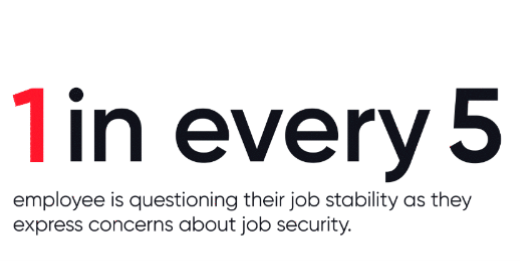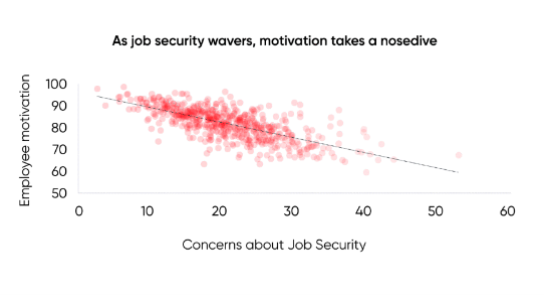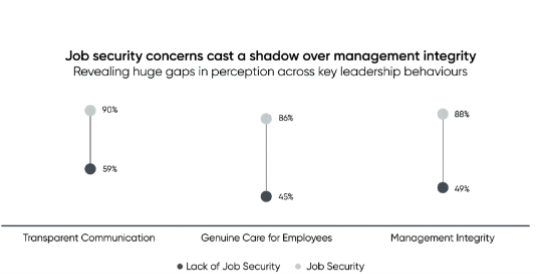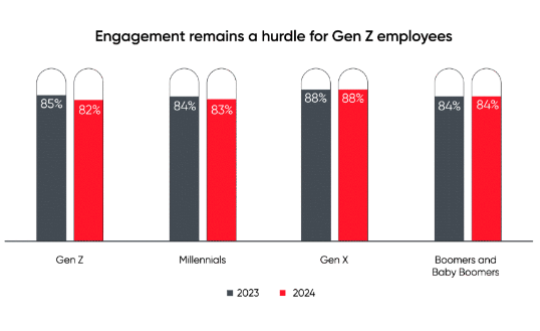Reading Time: 6 minutes
In an era where the IT & IT-BPM industry faces unprecedented challenges, the concept of Best Workplaces has evolved far beyond general perks like recreational centers or complementary meals. Today’s workplace culture stands at a critical crossroads, shaped by economic uncertainties, technological disruption, and shifting employee expectations. As organizations navigate through these turbulent times, building resilient workplace cultures has become more crucial than ever. The recent wave of layoffs and structural changes has created a complex landscape where trust, engagement, and cultural stability hang in delicate balance.
The Trust Paradox
The IT & IT-BPM sector, once a beacon of stability and growth, now grapples with a complex paradox. While 82% of employees find meaning in their work and feel they make a difference, organizations face growing challenges in maintaining engagement and trust. This disconnect points to a deeper truth: workplace culture isn’t just about satisfaction metrics—it’s about creating an environment where trust and purpose flourish together.

Recent trends reveal a concerning pattern of disengagement, particularly among younger generations. The rise of “silent quitting” and burnout, affecting 29% of IT employees—a 3% increase from the previous year—signals a critical need for cultural transformation. The primary culprits? Inflexibility and limited involvement in decision-making processes. This disengagement manifests not just in productivity metrics but in the subtle erosion of workplace relationships and collaborative spirit.
The Cultural Impact of Economic Uncertainty

The tech industry’s recent turbulence has created ripple effects throughout organizational cultures. When job security wavers, the impact extends far beyond immediate workforce concerns—it fundamentally alters how employees engage with their work and connect with their organizations. However, this period of disruption also presents an opportunity for forward-thinking organizations to redefine their cultural foundations and emerge stronger.

The I.M.P.A.C.T. Framework: Building Tomorrow’s Best Workplaces

Forward-thinking organizations are adopting comprehensive approaches to rebuild and strengthen their workplace cultures. The I.M.P.A.C.T. framework emerges as a blueprint for creating sustainable, engaging work environments:
I – Innovation through Collaboration
Despite the recognized value of cross-functional collaboration, only 23% of companies currently implement cross-functional teams effectively. This gap represents an untapped opportunity. Best Workplaces understand that innovation thrives when diverse perspectives converge, making collaborative environments a cornerstone of their culture. Organizations that successfully foster cross-functional collaboration report higher rates of innovation and employee satisfaction.
M – Meaningful Purpose
The data speaks volumes: 82% of employees find meaning in their work isn’t just a statistic—it’s a competitive advantage. Leading organizations are intentionally connecting individual roles to broader organizational goals, creating a sense of purpose that transcends daily tasks. This alignment becomes particularly crucial during periods of uncertainty, providing stability through shared mission and values. Best Workplaces actively cultivate this sense of purpose through clear communication of organizational impact and regular reinforcement of how individual contributions matter.
P – Promoting Internal Growth
The most resilient workplace cultures prioritize internal development, with 70% of organizations elevating their current leadership from within. This approach does more than fill positions—it builds institutional knowledge, strengthens cultural continuity, and demonstrates a tangible commitment to employee growth. Internal promotion strategies create visible career pathways that motivate employees and foster long-term commitment to organizational success.
A – Active Feedback Integration
In an age of rapid change, the ability to listen and adapt becomes crucial. While 80% of companies conduct engagement surveys, the true differentiator lies in how organizations act on this feedback. Best Workplaces stand out by closing the feedback loop, demonstrating that employee voices shape organizational direction. They create systematic approaches to not just collecting but implementing feedback, making it a cornerstone of their cultural evolution.
C – Communication for Empowerment
Perhaps the most telling is that only 30% of companies provide communication training to managers. This statistic illuminates a critical gap in workplace culture development. Effective communication serves as the bedrock of empowerment, enabling managers to delegate meaningfully and employees to contribute authentically. Best Workplaces invest heavily in developing communication capabilities across all organizational levels, recognizing their role in building trust and engagement.
T – Transparency as Trust’s Foundation
With 78% of companies maintaining defined grievance redressal processes, the framework for trust exists. However, true workplace culture excellence demands going beyond processes to create environments where transparency and accountability become natural elements of daily operations. Leading organizations are redefining transparency through regular updates on organizational direction, clear communication about challenges, and honest dialogue about both successes and failures.
The Future of Work: Emerging Trends Shaping Workplace Culture
As organizations chart their path forward, several key trends are reshaping the landscape of workplace culture:
1. Hybrid Work Evolution
The future workplace transcends physical locations, demanding cultures that foster connection and collaboration across digital and physical spaces. Best Workplaces are reimagining collaboration tools and practices to maintain cultural cohesion in hybrid environments. They’re developing innovative approaches to ensure remote employees feel as connected and engaged as their in-office counterparts.
2. Skills-First Culture
Traditional hiring models are giving way to skills-based approaches, emphasizing continuous learning and adaptability. Organizations are creating cultures where skill development becomes part of the daily workflow rather than an occasional training event. This shift requires new approaches to performance evaluation and career development that prioritize capabilities over credentials.
3. Purpose-Driven Sustainability
Environmental and social responsibility are emerging as powerful engagement drivers. Best Workplaces are integrating sustainability into their cultural DNA, recognizing its role in attracting and retaining purpose-driven talent. They’re creating initiatives that align organizational success with positive social impact, meeting the growing demand for meaningful work.
4. Accountability Culture
The most successful organizations are building cultures where accountability flows both ways—leaders to employees and employees to organization. This reciprocal relationship strengthens trust and drives engagement. Best Workplaces are implementing transparent metrics and regular check-ins to ensure accountability becomes a cultural strength rather than a management tool.
Addressing Generational Expectations

Modern workplace cultures must navigate diverse generational expectations, particularly as Gen Z enters the workforce with distinct preferences and values. Best Workplaces recognizes that creating inclusive cultures means understanding and accommodating different generational perspectives on work, success, and engagement. This understanding shapes everything from communication styles to career development approaches.
Building Resilience Through Culture
The path to becoming a Best Workplace isn’t linear. It requires constant attention, adaptation, and authentic commitment to creating environments where employees can thrive. As the IT industry continues to evolve, organizations that prioritize cultural resilience will find themselves better equipped to navigate future challenges.
The signs of strain are clear—from burnout to disengagement—but so are the opportunities for transformation. By focusing on trust, purpose, and meaningful connection, organizations can build workplace cultures that don’t just weather storms but emerge stronger from them.
Success in this endeavor requires more than policies and programs; it demands a fundamental shift in how organizations view and nurture their workplace culture. The Best Workplaces of tomorrow will be those that recognize culture as their most strategic asset, investing in it with the same rigor they apply to technological innovation.
As we look ahead, the question isn’t whether workplace culture matters—it’s how organizations will adapt their cultures to meet the evolving needs of their workforce while maintaining the trust and engagement that drive sustainable success. In this journey, the I.M.P.A.C.T. framework offers not just a roadmap but a foundation for building the resilient, engaging workplaces the future demands.
Get Certified to Showcase Your Commitment
Achieving Great Place To Work® Certification™ is an excellent way to demonstrate your organization’s commitment to employees’ overall well-being and experience. This Certification not only enhances your employer branding but also helps attract and retain top talent. It highlights to current and prospective employees that your organization values their overall well-being, fostering an environment where they feel appreciated and supported.
By implementing a culture of trust, respect, and collaboration, you can create a workplace where employees feel valued and connected. Certification also provides a benchmark for continuous improvement, helping you identify areas where you can further enhance employee well-being and overall workplace culture.
For All Summit Mumbai 2025: Vision to Value – Building Workplaces That Matter
Join us on February 6, 2025, in Mumbai for an enlightening day filled with insights on creating sustainable, humane, and inclusive workplaces. Learn from industry leaders about purpose-driven cultures, innovative HR practices, and adaptive leadership strategies.
Get your passes today – https://www.greatplacetowork.in/for-all-summit






